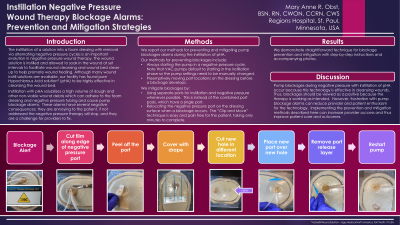Practice Innovations
(PI-018) Instillation Negative Pressure Wound Therapy Blockage Alarms: Prevention and Mitigation Strategies

Instillation with pHA solubilizes a high volume of slough and other non-viable wound debris which can adhere to the foam dressing and negative pressure tubing and cause pump blockage alarms. These alarms have several negative consequences; they are annoying to the patient, if not addressed the negative pressure therapy will stop, and they are a challenge for providers to fix.
Methods:
We report our methods for preventing and mitigating pump blockages alarms during the instillation of pHA.
Our methods for preventing blockages include:
Always starting the pump in a negative pressure cycle. Note that VAC pumps default to starting in the instillation phase so the pump settings need to be manually changed.
Preemptively moving ports locations on the dressing before a blockage develops.
We mitigate blockages by:
Using separate ports for instillation and negative pressure whenever possible. This is instead of the combined port pads, which have a single port.
Relocating the negative pressure port on the dressing surface when a blockage occurs. The “Clip and Move” technique is easy and pain free for the patient, taking only minutes to complete.
Results:
We demonstrate straightforward technique for blockage prevention and mitigation with step-by-step instructions and accompanying photos.
Discussion:
Pump blockages during negative pressure with instillation of pHA occur because this technology is effective in cleansing wounds. Thus, blockages should be viewed as a positive because the therapy is working as intended. However frustration with pump blockage alarms can reduce provider and patient enthusiasm for the technology. Implementing the prevention and mitigation methods described here can increase provider success and thus improve patient care and outcomes.
Trademarked Items: *Vashe® Wound Solution - Urgo Medical North America, Fort Worth, TX 76107
References: Kim PJ, Attinger CE, Constantine T, et al. Negative pressure wound therapy with instillation: International consensus guidelines update. Int Wound J. 2020;17:174– 186.
Hakkarainen, T. W., Kopari, N. M., Pham, T. N., & Evans, H. L. (2014). Necrotizing soft tissue infections: review and current concepts in treatment, systems of care, and outcomes. Current problems in surgery, 51(8), 344–362. https://doi.org/10.1067/j.cpsurg.2014.06.001

.png)